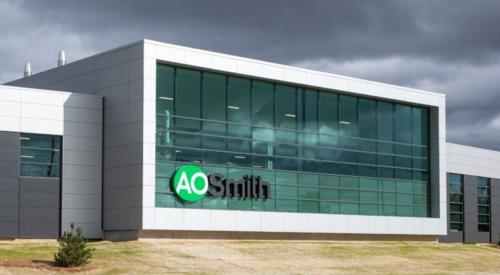America’s 10 largest publicly traded home builders have started to improve their policies and practices relating to the environment and resources, but much progress remains to be achieved, according to a new study by Calvert Investments, a sustainable and responsible investment firm. KB Home and Pulte ranked at the top of Calvert's list, while Meritage Homes, Toll Brothers, and Standard Pacific all improved against Calvert’s previous ranking. DR Horton and Ryland Group lost ground. (Pictured: Primrose models by KB Home at the Irvine Village of Portola Springs, Irvine, Calif.)
According to the report: “Out of 42 possible points, the average total score was just over six points, or 15 percent. While all 10 home builders have made some effort to develop environmental policies or practices, or to offer environmental products, there is strong differentiation in the level of commitment to sustainability and the penetration of ‘green’ homes in each company’s product mix. Without leading companies KB Home and Pulte Homes, the overall analytical performance of the industry in our study would have been far worse — scoring an average of less than 6 percent against key green data points.”
The top-10 home builders were ranked as follows for 2010:
- KB Home, Los Angeles (#1 in 2008)
- Pulte Homes, Bloomfield Hills, MI (tied for #2 in 2008)
- Meritage Homes, Scottsdale, AZ (#8 in 2008)
- Toll Brothers, Horsham, PA (#9 in 2008)
- Lennar, Miami, FL (#5 in 2008)
- DR Horton, Fort Worth, TX (tied for #2 in 2008)
- Standard Pacific, Irvine, CA (tied for #11 in 2008)
- NVR, Reston, VA (last at #13 in 2008)
- Ryland Group, Calabasas, CA (#6 in 2008)
- MDC Holdings Denver, CO (tied for #11 in 2008).
Green building represents a major opportunity to the industry as it focuses on rebuilding its market and restoring financial profitability. Estimated at $36-49 billion, the green building market is expected to increase twofold between 2009 and 2013. Homes account for about 21 percent of U.S. energy-related carbon dioxide emissions, a figure which places considerable responsibility on home builders to manage their contribution to climate change by addressing, among other things, the energy efficiency of their products.
“KB Home has maintained its #1 spot in our rankings. Toll Brothers, Meritage, and Standard Pacific have made modest to significant progress since our last review. Overall, the economic crisis has not thwarted many home builders’ efforts to become more sustainable companies,” said Stu Dalheim, Director, Shareholder Advocacy, at Calvert Asset Management Co., Inc. “With the increasing importance of issues such as energy supply, climate change, and smart growth, investors will need far greater disclosure from home builders in order to understand their capacity to address these major drivers. As with our previous survey, we found that the homebuilding industry still does not provide the information investors and consumers need. We believe that if these companies wish to continue as market leaders in new residential construction, they must not only embrace green building as a core business strategy, but also make information about their sustainability practices publicly available so that stakeholders can better understand, assess, and appreciate the efforts being undertaken.”
“Our survey of the 10 largest publicly traded U.S. home builders finds an evolving landscape. Whereas two years ago the industry had not yet begun to embrace sustainability as a core part of building design and construction, companies today have taken many meaningful steps toward developing greener and cleaner homes,” said Rebecca Henson, Sustainability Analyst at Calvert Asset Management Co., Inc. and co-author of the report. “Much of this progress may be attributable to companies’ recognition of the environmental, societal, and economic benefits of green building, as well as the critical roles that engaged stakeholders have diligently played over the past decade. However, given the environmental impact that homebuilding has, the industry has significantly more progress to make.”
“We are proud to maintain the #1 ranking among home builders,” said Jeffrey Mezger, President and Chief Executive Officer, KB Home. “While we realize there is more for us to accomplish as a company and as an industry to better the environment, we look forward to further educating consumers and paving the way through innovation and collaboration with other like minded companies.”
“Our in-depth review analyzes five areas that present significant challenges to the industry - land, building materials, energy, water, and climate change. While many home builders have made some regional efforts to address these five areas, we are witnessing the stirrings of an industry shift towards nation-wide implementation,” said Jennifer Green, Associate Sustainability Analyst at Calvert Asset Management Co., Inc. and co-author of the Report. “We are heartened to see that more companies are now favoring greater transparency than they were at the time of our last review. The leading companies in our survey have the first mover’s advantage in that they can influence industry trends and can be more flexible in responding to the stress a changing climate will no doubt place upon their operations.”
OTHER KEY FINDINGS
- Home builders are not measuring and disclosing their impact on the environment in a comprehensive manner. Calvert’s analysis looked for environmental performance data points that home builders use to measure and manage their footprint, but nearly all home builders had no relevant data.
- Whereas Calvert’s last report showed a preference towards regional policies and programs, home builders are now making company-wide, national sustainability commitments that pledge full product participation in energy, water, and climate change initiatives. At this point, KB Home is the only large U.S. home builder to produce a comprehensive sustainability report.
- Companies are most active in energy efficiency and conservation compared with other environmental issues. Every home builder reviewed for this analysis had some level of policy or program focused on curbing residential energy use. Our analysis shows that KB Home, Meritage Homes, and NVR (through its subsidiaries) have national commitments to build all new homes to EnergyStar standards.
- The 10 companies pay more attention to sustainability issues that can offer nearer-term financial benefits to operating costs and customers, such as building material recycling and energy and water efficiency measures. Issues with longer-term benefits, such as climate change, are not well addressed by this industry.
- In light of SEC interpretive guidance on climate change in early 2010, some home builders are choosing to disclose risks related to climate change through their annual 10-K filings. At this point, home builders appear most concerned about the effect of carbon regulation on costs, rather than direct physical impacts of a changing climate.
- Climate change may cause vulnerability to the homebuilding industry due to uncertainty of raw materials supply and land development characteristics, among other impacts. At the same time, the industry, whose products are responsible for over one-fifth of energy-related greenhouse gasses (GHGs), must prepare for future carbon regulation by the EPA. Finally, the industry must also address its use of timber as forests play a crucial role in both the cause and mitigation of climate change. Home builders have a long way to go with regard to climate change. Through our research we determined that seven of the 10 home builders did not report any significant information on its climate impact or the risks or opportunities that climate change may pose to the company. Pulte Homes and KB Home, responders to the Carbon Disclosure Project (CDP), are the only companies that currently report their levels of greenhouse gas emissions, although both companies are at early stages of capturing and disclosing this information.
For a full copy of the report, go to http://www.calvert.com.












